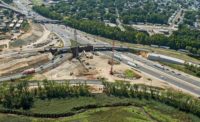A s Superstorm Sandy bore down on the New Jersey coast last fall, officials at the Southern Ocean Medical Center in Manahawkin huddled to figure out what to do. Nor'easters had historically pummeled the low-lying area laced with inlets, and so the hospital was taking the storm seriously. To compound problems, Southern Ocean was nearing the end of the first phase of a two-phase project to build a new emergency department (ED) and renovate its existing ED structure. The 32,500-sq-ft project would more than triple the ED's size and nearly double the hospital's patient rooms to 42.
Hoping for the best, the hospital secured the construction site and pushed up delivery of essentials—medicine, food and oil—by several days to ensure their arrival before the Oct. 29 storm. It also added cots for some of its 1,000 employees in case roads became impassable.
As it turned out, the eye of the storm passed directly over the hospital, which is located 24 ft above sea level and eight miles from the Atlantic Ocean. Even so, the hospital came through the storm with almost no damage, thanks in part to one particular feature of the $22-million construction project—an L-shaped pond built to capture rainwater.
Good Diversion
The construction team led by Red Bank, N.J.-based general contractor Torcon Inc. had built the more than 5,000-sq-ft pond last summer to replace a smaller pond that was demolished to make way for a new parking lot. Like the old pond, the new one would divert water from parking lots during heavy storms and funnel water away from roadways that are nearly flush with the building's main floor, says Dale McElhone, Southern Ocean facilities manager. However, when Sandy hit, the pond became a collection point for would-be floodwaters that devastated nearby Long Beach Island and much of the region.
Also, unlike many other hospitals along the Northeast coastline that were ravaged by the storm, Southern Ocean was able to keep the lights on even though the region lost power for 32 hours. That was due to the hospital's two backup generators that never went off, says Frank J. Little Jr., principal at Beachwood, N.J.-based Owen Little & Associates, the site engineer.
After the storm, the hospital added another backup generator to further bolster its defenses during future storms, says Little, whose firm has worked for the hospital since the 1980s.
Supply Delays
Despite the hospital's resilience post-Sandy, the storm caused the jobsite to be shut down for a week and delayed the project's target completion date by two months, to this August.
"We have tried to catch up but have not succeeded at the present time," McElhone says.
The delay was largely due to local suppliers that were hit hard by the storm and could not make deliveries, McElhone says. This included, for example, the West Caldwell, N.J.-based Sloan & Co, which milled the wood finishes for nurses' stations. The firm lost power to its warehouse, which delayed production for three weeks.
Other challenges came from the fact that the project also required more approvals and permits than usual, as it sits next to Ocean Acres, a 1960s subdivision, and near the Pine Barrens forest area. The local planning board and state Dept. of Health had to sign off, as well as the Dept. of Transportation, over concerns that too much patient traffic would pour onto narrow local roads. The state's Pinelands Commission, which regulates development, also had to green-light work, contributing to the lengthy four-month approval process.
The biggest challenge early on, however, was how to keep the hospital running seamlessly during two years of construction, McElhone says. This led to the decision to divide the project into two main phases, he says. The first focused on the northern half of the site, with the second on the southern portion. The existing ED, located in the southern part, continued to operate while new facilities were built to the north.
The first phase, completed last December, included extensive excavation and sitework to build the 17,500-sq-ft new ED, McElhone says. It also included the demolition of an unused histology lab and building an entryway on the north side to be used by ambulances.
Birdsall Services Group, Eatontown, N.J., the project's mechanical, electrical and plumbing (MEP) engineer, wrapped up ductwork and installed electrical and plumbing systems pre-Sandy, McElhone says. In addition, a single-ply membrane roof was installed before the storm, as was much of the interior work, including telecom systems, sprinkler heads and signage.
Phase 2, which began in January, is focused on 7,900 sq ft of space, most of which is being renovated. The renovation includes making way for seven operating rooms and behavioral health treatment space in addition to offices.
To ensure continuity of operations, the 12 patients who were housed in the existing ED were moved to the newly built northern half, so that the team could reconfigure existing patient suites and remodel the hospital's entryway for walk-ins only.
The walk-in entry, designed by project architect Pennington, N.J.-based Saphire + Albarran Architecture, is meant to evoke sailboats, like the kind that cruise on Barnegat Bay a few miles from the hospital. The team is adding five tall masts that protrude from the top of a 90-ft-wide canopy, which cantilevers out 26 ft over the entry. It will also install a new ceiling inside the lobby, which is meant to resemble the wood hull of a ship. Workers will add a layered stone wall that will feature a gas fireplace.
Structural engineer O'Donnell & Naccarato, Philadelphia, has recently erected steel frames. In the next stage, the team will pour concrete slabs and spray fireproofing material.
By summer, mechanical systems and drywall will be installed and ceilings and millwork will go in next. Equipment will be commissioned before the project is occupied, which is scheduled for Aug. 15.
Throughout the project, construction areas have been screened off from the working ED. The project team constructed a 6-in.-wide, metal-and-drywall temporary wall along the edge of a main hallway, which essentially became an outside wall. Painted off-white to resemble existing walls, the barrier kept up appearances while patients came and went, McElhone says.
The barrier is also decorated with renderings of what's to come, he says. "We wanted people not to think they were in anything but a finished product," he adds.







Post a comment to this article
Report Abusive Comment